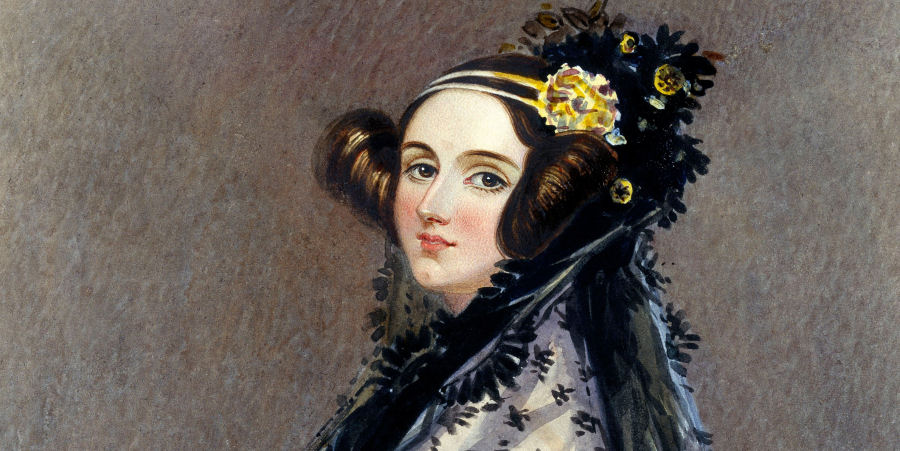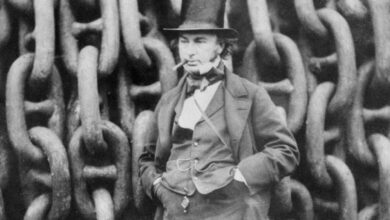
“The Analytical Engine does not occupy common ground with mere ‘calculating machines.’ It holds a position wholly its own, and the considerations it suggests are more interesting in their nature” – Ada Lovelace.
Podcast: Play in new window | Download
Subscribe: Spotify | Amazon Music | Youtube Music | RSS
Ada Lovelace Biography
Augusta Ada King, Countess of Lovelace was born in London, England on 10 December 1815. She was the daughter of the poet Lord Byron, and his wife Anne Isabella, the Lady Byron.
Lord Byron was hoping that he would be blessed with a son as until now he had no legitimate children, but he was to be left with no male heir following Ada’s birth, as the couple were in the process of separating and only a month later, Ada Lovelace saw her father for the last time when Lady Byron left the family home to live with her parents at Kirkby Mallory, taking Ada with her. Lord Byron formally separated from his wife when he signed the associated documents on 21 April. He left England forever only a few days later. Although English law at the time granted full custody of children to the father in cases of separation, Byron seemed not to be interested and left the girl in the care of her mother.
Ada Lovelace never had a relationship with her father as he died when she was eight and unfortunately she also did not have a close relationship with her mother being left in the care of Lady Milbanke, Lady Byron’s mother. Lady Byron only asked about her welfare occasionally in order to keep up appearances and as Ada grew into a teenager, she had her watched by close friends in order to identify any evidence of moral deviation which she was convinced Ada would inherit from her father.
Ada was often ill as a child, suffering from debilitating headaches and was even paralysed in 1829 after contracting measles following which she was confined to bed for almost a year. Despite her illnesses, she developed an interest in mathematics and technology and when she was twelve, she declared that she wanted to fly. Instead of this being just the fanciful notion of a child, Ada Lovelace actually set about methodically constructing apparatus that would help her to do so starting with wings in February 1828. In order to ensure that the wings would be of the correct size and weight, she studied the anatomy of birds and researched a number of different materials from which she might construct them. During the process, Ada also wrote a book which she called Flyology within which she illustrated some of her findings.
In 1833, Ada Lovelace had an affair with one of her tutors. She tried to elope with him, but relatives of the tutor recognised Ada and informed her mother of the couple’s whereabouts. Lady Byron, with the help of her friends, covered up the affair due to the scandal that it would cause.
In the same year, Ada became friends with another of her tutors, Mary Somerville, who introduced her to Charles Babbage. She also became acquainted with other influential people at the time including Michael Faraday and Charles Dickens and at the age of only seventeen she was presented at court and by 1834, she was a court regular.
A year later, on 8 July Ada Lovelace married William, 8th Baron King, thereby becoming Lady King. The couple spent their time at three different homes, one in Surrey, one in London and also a Scottish estate on Loch Torridon. The couple also had a Summer retreat at Worthy Manor in Somerset, which had been the setting for their honeymoon.
The couple went on to have three children together, Byron in 1836, Anne Isabella in 1837 and Ralph Gordon in 1839. In 1838 William was made Earl of Lovelace as Ada was descended from the by then extinct line, resulting in Ada became Countess of Lovelace.
In 1840, one of Ada’s acquaintances, Charles Babbage attended a seminar at the University of Turin where he talked about his Analytical Engine. The lecture was translated into French and published in 1842. Subsequently, a friend of Babbage’s, Charles Wheatstone, commissioned Ada Lovelace to translate the lecture into English. She did so, but also added her own notes to the text assisted by Babbage himself. These notes, which were much more detailed than the original transcript of the lecture were published in 1843 under the initialism AAL in Taylor’s Scientific Memoirs and consider the fact that the Analytical Engine was far more than a simple calculating machine and that it could be programmed to solve many types of complex problems.
For example, Ada’s note G (her notes were all labelled A to G) describes an algorithm that would be used by the Analytical Engine to calculate Bernoulli numbers and is considered to be the first-ever algorithm published, specifically intended for use on a computer. For this reason, Ada Lovelace has often been described as the world’s first computer programmer. Unfortunately, the Analytical Engine was never built and so the program was never tested.
Controversy over the subject of Ada Lovelace’s contribution to the Analytical Engine and its potential programming has raged ever since, with some historians doubting that Ada made much of a contribution at all other than to publish what had already been written by Babbage, although the question must be asked why Babbage would allow publication under the initials AAL if it was essentially his work being published.
Ada Lovelace’s life during the rest of the 1840s was not without scandal as there were many rumours of affairs with married men as well as her love of gambling. She allegedly lost more than £3000 betting on horse racing later in the decade. She even tried to apply a mathematical model to gambling and elicited the help of some of her male friends, forming a betting syndicate to which she became thousands of pounds in debt, thus forcing her to admit everything to her husband.
In the middle of 1852 Ada Lovelace became seriously ill and on 27 November the same year following several months of illness, she died from uterine cancer at the age of only 37, the same age as her father upon his death. At her own request, she was buried at the side of her father, Lord Byron, at the Church of Mary Magdelene in Hucknall, Nottinghamshire.
Podcast: Play in new window | Download
Subscribe: Spotify | Amazon Music | Youtube Music | RSS




